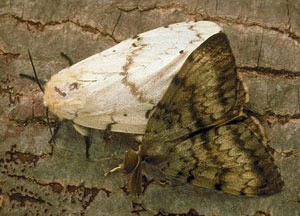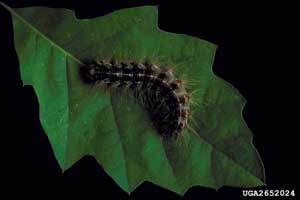
Identification
Gypsy Moths are usually only seen around mid-summer. The male moths are a grayish brown color and can fly. The female moths cannot fly, are larger in size and have a whitish color with black markings. Females lay egg masses on tree trunks, outdoor furniture and the sides of buildings, which appear as tan or buff-colored hairs. The larvae hatch in the spring. Gypsy Moth caterpillars are 2-inches long with tufts of brown and yellow hair extending from their sides.
At the head end of their bodies, they have 10 blues spots on their back, followed by red spots. As a group, caterpillars do not spin tents, but individuals will climb down trees to spin a loose, leathery cocoon to pupate. The gypsy moth population explodes about every four years due to natural predator cycles.
Favorite Plants
Gypsy Moths feed on hundreds of species of trees, but prefer oaks and aspen.
Damage
Large outbreaks of gypsy moths can definitely defoliate and kill trees. Caterpillars generally feed at night and will migrate down trees during the day, sometimes abandoning one tree and eating their way through a path of plants on their way to another.
Organic Methods of Control:
Cultural or Mechanical
- Clean up leaves and limbs around trees in the fall.
- Hand pick caterpillars and pupae from trees.
- Tie a rope around trees and drape a burlap sack over it. As the caterpillars gather here during the day remove them.
- Scrape off and destroy eggs and cocoons.
- Spray caterpillars off of trees, plants and sides of buildings with a strong jet of water from the garden hose.
Biological
- Release lacewings to attack eggs.
- Apply parasitic nematodes to wet tree trunks and on the moist ground below to kill migrating caterpillars.
- Spray tree foliage with Bt (Bacillus thuringiensis) at the first sign of infestations.
Chemical
- Use lime and soap spray directly on caterpillars and eggs.

